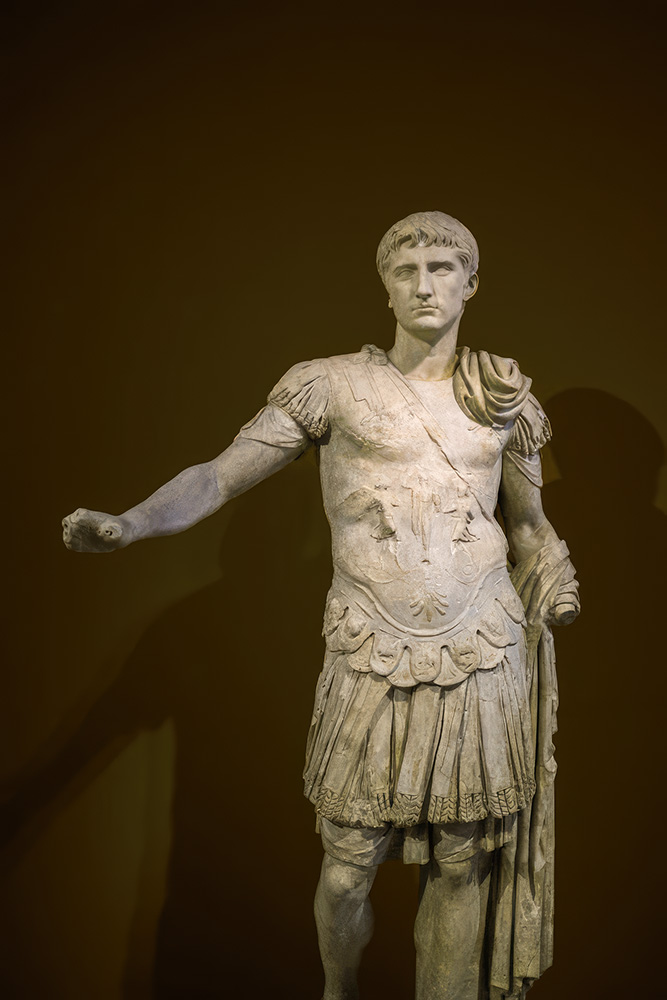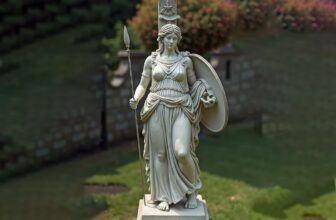
Why Are Roman Busts Sculpture So Realistic
In the grand narrative of art history, few legacies loom as large as that of ancient Rome. From sweeping marble temples to the fine details of mosaic floors, the Roman Empire’s artistic achievements have captivated scholars, artists, and the general public for centuries. Among these accomplishments, one form of artistic expression continues to stand out for its realism, cultural insight, and enduring mystery: the Roman bust.
Roman warrior bust sculptures, powerful renderings of military leaders, emperors, and noble citizens, remain some of the most compelling artifacts from antiquity. With furrowed brows, stern gazes, and lifelike imperfections, these works defy the idealism often associated with classical art. But what lies behind their uncanny realism? How did Roman artists achieve such authenticity centuries before the advent of modern techniques? And what role did these busts play in the broader tapestry of Roman society and identity?
Let’s explore the fascinating story of Roman warrior busts, their artistic innovations, their historical context, and even the curious modern fascination with one Roman bust that bears an uncanny resemblance to Elvis Presley.
Why Are Roman Busts So Realistic?
The realism of Roman busts, especially those of warriors and statesmen, is one of their most defining and praised characteristics. Unlike the idealized forms of earlier Greek sculpture, Roman busts often depict their subjects with a brutal honesty, wrinkled skin, balding heads, scowling mouths, and even crooked noses.
This realism, known in scholarly terms as verism (from the Latin verus, meaning “true”), was rooted in Roman cultural values. Romans admired gravitas (seriousness), virtus (manliness, courage), and dignitas (dignity). These virtues were often associated with age and experience. A deeply lined face or a stern expression wasn’t a flaw, it was a badge of honor, evidence of a life lived in service to the Republic or Empire.
Verism found its most powerful expression in portrait busts, which were often created to memorialize ancestors and respected public figures. The aim was not to glorify the individual with ideal beauty but to honor their legacy and communicate their moral character. This stark, sometimes unflattering realism was seen as an embodiment of truth.
How Was Roman Art Made to Look So Realistic?
Achieving such realism wasn’t merely a matter of style, it was also a technical triumph. Roman artists, many of whom were actually Greek slaves or freedmen trained in the Hellenistic tradition, utilized a variety of techniques to capture their subjects with stunning accuracy.
Death Masks and Wax Portraits (Imagines):
Wealthy Roman families kept wax masks of deceased ancestors in their homes. These masks, called imagines, were created from actual death masks, capturing the unique contours of the face. These were sometimes used as references for sculptors, providing a direct physical likeness to replicate in marble or bronze.Live Sittings and Sketching:
While photography did not exist, live sittings and detailed sketches allowed artists to capture a person’s likeness. They studied not just the facial features but also the character of the individual, how they held themselves, their expression, their demeanor.Tooling and Marble Carving:
Artists employed a sophisticated set of tools, point chisels, claw chisels, and abrasives, to carve incredibly detailed textures. From skin folds to beard stubble to the fine grain of hair, the level of detail is breathtaking even by modern standards.Color and Finishing Touches:
Contrary to the modern image of pristine white marble, Roman busts were often painted. Skin tones, hair color, and even eyes were painted to enhance the realism. The paint has mostly faded with time, but traces remain to tell us that these sculptures were once lifelike in more than just form.
The Historical Roots and Role of Roman Busts
The tradition of bust sculpture in Rome has deep historical roots and evolved significantly over time. Let’s trace the arc of Roman busts from their Republican origins to their imperial grandeur.
1. The Republican Era (509–27 BCE): Verism and Ancestral Veneration
During the Roman Republic, busts were primarily commemorative. Aristocratic families displayed portraits of their ancestors in the atrium of their homes. These served both as markers of lineage and as moral reminders of familial virtue. The practice of imagines maiorum (images of the ancestors) allowed Romans to reinforce their status and social role through visual means.
Busts of warriors during this time often depicted grim faces, battle scars, and aged features. These were not heroic statues meant to glorify but truthful tributes to endurance, loyalty, and martial courage.
2. The Early Empire (27 BCE–96 CE): Idealism Meets Realism
With the rise of Augustus, the first emperor, there was a shift in tone. While early imperial busts retained elements of realism, they also began incorporating idealized features reminiscent of Greek Classical art. Augustus himself is famously depicted as eternally youthful in most busts, promoting a sense of divine perfection and political stability.
However, busts of generals and less prominent figures retained more realism. This blending of styles, verism and idealism, created a unique visual language for the Empire.
3. The High Empire (96–192 CE): Monumentality and Psychological Depth
During the reigns of emperors like Trajan, Hadrian, and Marcus Aurelius, busts became more monumental and expressive. Hadrian’s bearded look marked a shift in fashion, inspired by Greek philosophers, and Marcus Aurelius’s busts often convey introspection and fatigue, appropriate for a philosopher-king.
Military busts during this period showed hardened faces, expressive eyes, and a powerful sense of identity. These were not mere likenesses but psychological portraits, often hinting at the pressures of leadership or the brutality of war.
4. The Late Empire (193–476 CE): Abstraction and Symbolism
As the Empire began to decline, so too did the finesse of its art. Busts became more abstract and symbolic, often with disproportionately large eyes or geometric features. These were less concerned with individual personality and more about imperial authority or religious symbolism.
Even in this stylistic shift, Roman busts remained an important means of communication, depicting power, divine favor, or military command.
The “Elvis” Bust: When Antiquity Echoes Pop Culture
One of the more humorous and viral intersections of Roman art and modern pop culture is the “Elvis Bust.” Found in the British Museum’s collection, this marble head of a Roman youth from the 2nd century CE bears an uncanny resemblance to Elvis Presley, the high cheekbones, full lips, and famously styled pompadour hair.
While obviously coincidental, the comparison highlights the universality of human features across time. The resemblance has sparked both amusement and serious reflection on how our perceptions of beauty and charisma are shaped. Was this youth considered a “rock star” of his day? Perhaps he was a fashionable nobleman or even a military officer with flair.
Whether or not the resemblance was intended, the Elvis bust invites us to connect with the humanity of the ancient world, not as a relic of a distant past, but as a mirror of ourselves.
The Most Famous Roman Sculpture
When discussing the most iconic Roman sculpture, a few contenders immediately rise to the top. But arguably, the most famous is the Augustus of Prima Porta.
Discovered in 1863 in the villa of Livia (his wife), the statue depicts Emperor Augustus in full military regalia, his right hand raised as if addressing troops or giving a divine command. While technically a full-body statue, its upper half functions as a bust-like portrait and embodies the fusion of political propaganda, artistic mastery, and symbolic messaging.
What makes the Augustus of Prima Porta so famous?
Idealization Meets Realism: Though idealized, the face retains a clear likeness to Augustus’s known features.
Symbolism: His breastplate tells a story of diplomatic victory, while Cupid at his feet links him to the gods.
Imperial Power: The sculpture redefined what it meant to depict an emperor, not as a mortal, but as a godlike figure commanding authority and respect.
Other notable Roman busts include the Capitoline Brutus (a stark example of Republican verism), the Bust of Caracalla (famous for its angry, intense expression), and Portrait of a Flavian Woman (notable for its intricate hairstyle and craftsmanship).
How A Roman warrior bust sculpture is typically made
A Roman warrior bust sculpture is typically made from a variety of materials depending on its intended purpose, time period, and level of detail. The most common materials used in classical Roman times included marble, bronze, and terracotta. Each material provided different aesthetic qualities and levels of durability.
Marble was the most prestigious and widely used material for Roman busts, especially for commemorating military leaders and emperors. Roman artists valued marble for its smooth texture, fine grain, and ability to hold intricate details. The white or lightly veined marble, often sourced from quarries in Italy or Greece, allowed sculptors to capture realistic facial expressions, the folds of military cloaks, and the intricate details of helmets and armor.
Bronze busts were also common, especially for public display. Unlike marble, bronze allowed for more dynamic poses and finer sculpting of small features like curls of hair or engraved armor. However, far fewer bronze sculptures survive today because the material was often melted down for reuse. When preserved, bronze busts exhibit a powerful, lifelike presence due to their metallic sheen and durability.
Terracotta (baked clay) was a more affordable and accessible medium used for busts intended for private homes or modest public spaces. These were usually less detailed but still conveyed the subject’s status and military prowess.
Occasionally, busts would be painted or gilded to enhance realism. Eyes might be inlaid with glass or stone, and helmets or tunics could be painted in reds and golds.
In modern reproductions or decorative sculptures, materials like resin, plaster, or concrete may be used to replicate the look of ancient busts at a lower cost.
Overall, Roman warrior bust sculptures reflect a blend of artistry, symbolism, and material craftsmanship representative of Roman military prestige.
Influence of Roman Warrior Busts in Modern Art and Culture
Roman busts have profoundly influenced Western art. The Renaissance saw a revival of Roman sculptural techniques, with artists like Michelangelo and Bernini studying ancient busts for inspiration. Neoclassical art in the 18th and 19th centuries borrowed heavily from Roman forms, equating civic virtue with Roman aesthetics.
Today, busts appear in museums, civic buildings, and even private collections. Their presence lends an air of authority, intellectual rigor, and historical continuity. More recently, artists have reimagined busts with modern twists, using materials like plastic, bronze alloys, or even digital media.
The enduring appeal of Roman busts lies not only in their beauty or technical skill but in their humanity. They offer a timeless glimpse into the lives, struggles, and values of individuals who, though long gone, still seem to watch us from across the centuries with knowing eyes.
Roman warrior busts are more than just stone. They are vessels of memory, power, and personality. Each furrowed brow, pursed lip, or etched scar tells a story of a person who once commanded armies, debated in the Senate, or honored the gods.
The realism of these busts is not a mere artistic flourish, it is a window into the soul of Rome itself. A civilization obsessed with legacy, with the visible markers of virtue and honor, Rome embedded its values into marble and bronze so that they could be passed down through time.
Even now, thousands of years later, we can look into the eyes of a Roman warrior and see more than a sculpture. We see a person, flawed, proud, determined, human. And perhaps that is the greatest triumph of Roman art: not that it depicted reality, but that it preserved it.



